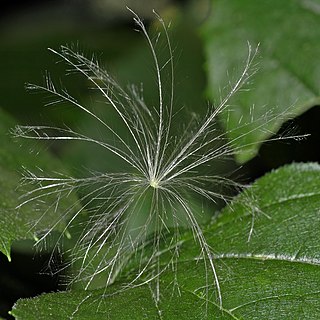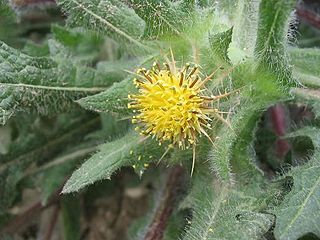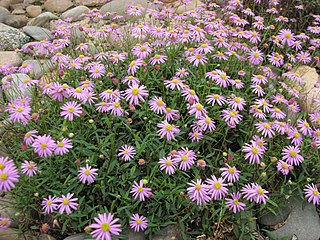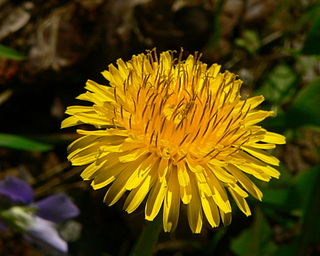
Asterales is an order of dicotyledonous flowering plants that includes the large family Asteraceae known for composite flowers made of florets, and ten families related to the Asteraceae.

Solidago, commonly called goldenrods, is a genus of about 100 to 120 species of flowering plants in the aster family, Asteraceae. Most are herbaceous perennial species found in open areas such as meadows, prairies, and savannas. They are mostly native to North America, including Mexico; a few species are native to South America and Eurasia. Some American species have also been introduced into Europe and other parts of the world.

The pappus is the modified calyx, the part of an individual floret, that surrounds the base of the corolla tube in flower heads of the plant family Asteraceae. The term is sometimes used in other plant families such as Asclepiadaceae (milkweeds), whose seeds have a similar structure attached, although it is not related to the calyx of the flower.
Harold Ernest Robinson is an American botanist and an entomologist.

The Heliantheae are the third-largest tribe in the sunflower family (Asteraceae). With some 190 genera and nearly 2500 recognized species, only the tribes Senecioneae and Astereae are larger. The name is derived from the genus Helianthus, which is Greek for sun flower. Most genera and species are found in North America and South America, particularly in Mexico. A few genera are pantropical.

Vernonia is a genus of about 1000 species of forbs and shrubs in the family Asteraceae. Some species are known as ironweed. Some species are edible and of economic value. They are known for having intense purple flowers. The genus is named for the English botanist William Vernon. There are numerous distinct subgenera and subsections in this genus. This has led some botanists to divide this large genus into several distinct genera. For instance, the Flora of North America only recognizes about 20 species in Vernonia sensu stricto, 17 of which are in North America north of Mexico, with the others being found in South America.

Eupatorium is a genus of flowering plants in the aster family, Asteraceae, containing from 36 to 60 species depending on the classification system. Most are herbaceous perennials growing to 0.5–3 m (1.6–9.8 ft) tall. A few are shrubs. The genus is native to temperate regions of the Northern Hemisphere. Most are commonly called bonesets, thoroughworts or snakeroots in North America. The genus is named for Mithridates Eupator, king of Pontus.

In botany, a rosette is a circular arrangement of leaves or of structures resembling leaves.

Cnicus benedictus, is a thistle-like plant in the family Asteraceae, native to the Mediterranean region, from Portugal north to southern France and east to Iran. It is known in other parts of the world, including parts of North America, as an introduced species and often a noxious weed. It is the sole species in the monotypic genus Cnicus. Other species once included in the genus have largely been reclassified to Cirsium, Carduus, and Centaurea.

Crepis, commonly known in some parts of the world as hawksbeard or hawk's-beard, is a genus of annual and perennial flowering plants of the family Asteraceae superficially resembling the dandelion, the most conspicuous difference being that Crepis usually has branching scapes with multiple heads. The genus name Crepis derives from the Greek krepis, meaning "slipper" or "sandal", possibly in reference to the shape of the fruit.

Calyceraceae is a plant family in the order Asterales. The natural distribution of the about sixty species belonging to this family is restricted to the southern half of South-America. The species of the family resemble both the Asteraceae family and the Dipsacaceae.

Brachyscome is a genus of flowering plants in the aster family, Asteraceae. Most are endemic to Australia, and a few occur in New Zealand and New Guinea.

The Cynareae are a tribe of flowering plants in the daisy family (Asteraceae) and the subfamily Carduoideae. Most of them are commonly known as thistles; four of the best known genera are Carduus, Cynara, Cirsium, and Onopordum.

Sonchus arvensis, the field milk thistle, field sowthistle, perennial sow-thistle, corn sow thistle, dindle, gutweed, swine thistle, or tree sow thistle, is a species of flowering plant in the daisy family Asteraceae. S. arvensis often occurs in annual crop fields and may cause substantial yield losses.

Asteroideae is a subfamily of the plant family Asteraceae. It contains about 70% of the species of the family. It is made of several tribes, including Astereae, Calenduleae, Eupatorieae, Gnaphalieae, Heliantheae, Senecioneae and Tageteae. Asteroideae contains plants found all over the world, many of which are shrubby. There are about 1,135 genera and 17,200 species within this subfamily; the largest genera by number of species are Helichrysum (500-600) and Artemisia (550). Asteroideae is said to have begun approximately 46-36.5 million years ago.

The Cichorieae are a tribe in the plant family Asteraceae that includes 93 genera and more than 1600 sexually reproductive species and more than 7000 apomictic species. They are found primarily in temperate regions of the Eastern Hemisphere. Cichorieae all have milky latex and flowerheads that only contain one type of floret. The genera Gundelia and Warionia only have disk florets, while all other genera only have ligulate florets. The genera that contain most species are Taraxacum with about 1600 apomictic species, Hieracium with about 770 sexually reproducing and 5200 apomictic species, and Pilosella with 110 sexually reproducing and 700 apomictic species. Well known members include lettuce, chicory, dandelion, and salsify.

Taraxacum is a large genus of flowering plants in the family Asteraceae, which consists of species commonly known as dandelions. The genus is native to Eurasia and North America, but the two commonplace species worldwide, T. officinale and T. erythrospermum, were introduced from Europe and now propagate as wildflowers. Both species are edible in their entirety. The common name dandelion is given to members of the genus. Like other members of the Asteraceae family, they have very small flowers collected together into a composite flower head. Each single flower in a head is called a floret. In part due to their abundance along with being a generalist species, dandelions are one of the most vital early spring nectar sources for a wide host of pollinators. Many Taraxacum species produce seeds asexually by apomixis, where the seeds are produced without pollination, resulting in offspring that are genetically identical to the parent plant.

Argyroxiphium grayanum, commonly known as the greensword, is a species of flowering plant in the sunflower family, Asteraceae, and a member of the silversword alliance, a group of over 50 species which are diverse in morphology and habitat but are genetically closely related.
Famatinanthus is a genus in the daisy family that was created in 2014 and has been reassigned to its own tribe Famatinantheae and subfamily Famatinanthoideae. It contains only one known species, F. decussatus, a small shrub of ½—1¾ m high that is an endemic of the Andes of north-western Argentina, with small, entire, oppositely set leaves and flowerheads containing about ten cream-colored, ray and disk florets, with backward coiled lobes. It is locally known as sacansa. For more than 100 years, the species was known to science only from the type collection used for the 1885 description which had assigned it to the genus Aphyllocladus.




















